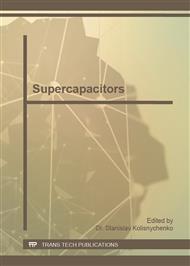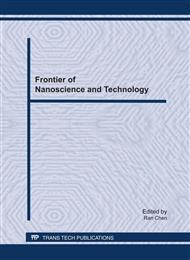p.195
p.200
p.205
p.209
p.214
p.219
p.224
p.229
p.234
Effects of Deposition Temperatures on the Nanoflakes Co(OH)2 Porous Films for Supercapacitors
Abstract:
Nanoflakes Co(OH)2 porous films were successfully synthesized by a facile electrochemical technique. The morphology was characterized by field emission scanning electron microscopy (FESEM). Electrochemical techniques such as cyclic voltammetry (CV), galvanostaitc charge/discharge and electrochemical impedance spectroscopy were used to study the effects of deposition temperatures on the capacitance of the films. The results exhibited that the Co(OH)2 films single electrode had high specific capacitance in KOH electrolyte. A maximum specific capacitance of 2780 F/g could be achieved for the Co(OH)2 film deposited at 50°C in 2 M aqueous KOH with 0 to 0.4V potential at a charge-discharge current density of 4 mA/cm2. Therefore, the obtained nanoflakes Co(OH)2 porous films can be a potential application electrode material for supercapacitors.
Info:
Periodical:
Pages:
214-218
Citation:
Online since:
July 2011
Authors:
Price:
Сopyright:
© 2011 Trans Tech Publications Ltd. All Rights Reserved
Share:
Citation:



